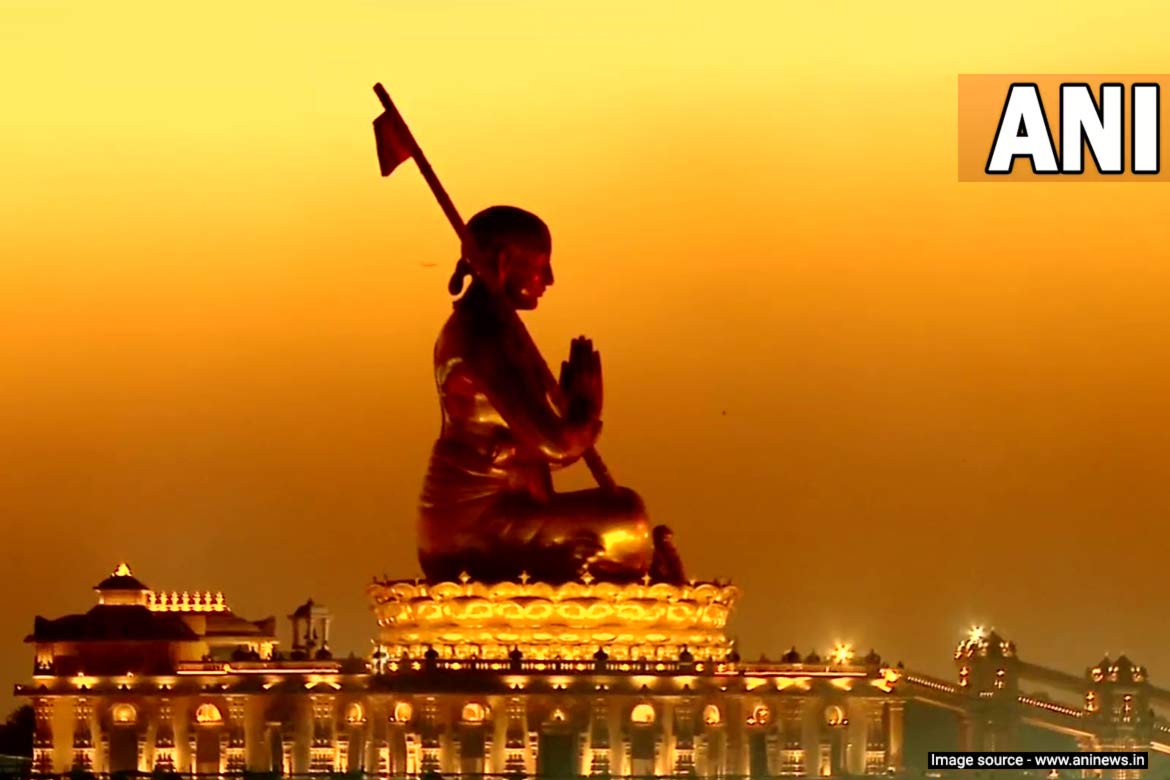On January 5, PM Modi unveiled a 216-feet tall statue of 11th-century social reformer saint Ramanujacharya in Hyderabad. As Ramanujacharya was a proponent of equality, this statue is named ‘Statue of Equality. The inauguration of this statue is a part of the 12-day long celebration of the ongoing 1000th birth anniversary of Ramanujacharya. Here, we will tell you about the newly revealed statue and saint Ramanujacharya.
Facts about this statue:
- This 216 feet high statue, is made of ‘Panchaloha’ i.e. combination of five metals- gold, silver, copper, brass and zinc.
- This statue is installed on a 54 feet high building named ‘Bhadra Vedi’. It includes a Vedic digital library and research centre, ancient Indian texts, a theatre and an educational gallery detailing the many works of Sri Ramanujacharya.
- The Statue of Equality is the second tallest sitting posture statue in the world after the Buddha statue in Thailand.
- The inner sanctum deity of Ramanujacharya is made of 120 kg of gold to commemorate the 120 years the saint walked this earth.
- The entire project of the Statue of Equality is spread over 45 acres.
- The total cost of the project is about Rs 1000 crore. However, this entire project has been completed with donation money and the land for this was donated by Jupally Rameswar Rao of My Home Group.
- This statue has been made in China and after that, it was brought to India. All the work of making it was done in China and then it was brought to India in about 1600 pieces. This statue was assembled in India.

Also read: Here Is The List Of 10 Tallest Statues In India
Who was Ramanujacharya:
In keeping with his idea of ‘Vasudhaiva Kutumbakam (the world is one family)’, India is celebrating his 1,000th birth anniversary as a ‘festival of equality’.
Early life:
Born in the year 1017 in Sriperumbudur, Tamil Nadu, Ramanujacharya was a Vedic philosopher and social reformer. He was named Lakshman at the time of his birth. Saint was also known as Ilaya Perumal, which means radiant.
He travelled across India advocating equality and social justice. He revived the Bhakti movement and his teachings inspired many Bhakti ideologies. He is considered an inspiration for poets like Annamacharya, Bhakta Ramdas, Tyagaraja, Kabir and Mirabai.
His contribution:
Ramanujacharya is famous as the main proponent of the sub-branch of Vishishtadvaita of Vedanta. It is a monistic tradition of Vedanta philosophy. This is the monism of the omnipotent Supreme Being, in which only Brahma is believed to exist, but it manifests itself in various forms.
He composed nine scriptures known as Navaratnas and composed many commentaries on Vedic scriptures. Ramanuja’s most important writings include his commentary on the ‘Vedanta Sutra’, Sri Bhashya or true commentary and commentary on the Bhagavad-gita, Gitabhasya. His other writings include ‘Vedanta Sangrah’, which is a summary of the meaning of the Vedas, Vedantasara, i.e, the essence of Vedanta and Vedantadeep meaning Lamp of Vedanta.
Read more: FROM GEORGE V TO NETA JI: KNOW THE FEATURES OF THE NEW HOLOGRAM STATUE OF S.C. BOSE
His ideas on equality:
Ramanujacharya stressed the need to harmonize with nature and not over-exploit the resources. He was an advocate of social equality among all classes of people centuries ago and encouraged the opening of temple doors to all irrespective of caste or status in society, at a time when the entry of people of various castes was not allowed.
He took education to those who were deprived of it. His greatest contribution is the promotion of the concept of ‘Vasudhaiva Kutumbakam’, which means ‘the whole universe is one family’.
He travelled across India for many decades, preaching his ideas of social equality and universal brotherhood in temples through his speeches. He embraced the socially marginalized people and condemned the reasons for their condition and asked the royal courts to treat them equally.
Moreover, the saint spoke of universal salvation through devotion to God, compassion, humility, equality and mutual respect in what is known as the Sri Vaishnava Sampradaya.
Ramanujacharya freed millions of people from social, cultural, gender, educational and economic discrimination with the fundamental belief that every human being is equal before nationality, gender, caste, creed.
